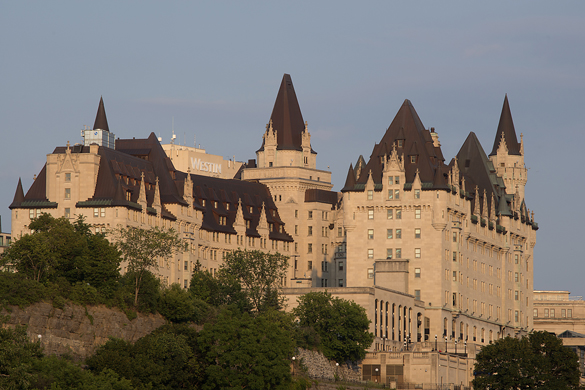If architects had written a Declaration of Independence in the 20th century, it might have begun with the words: “We hold this truth to be self-evident, that all imitation of historical styles is repugnant and odious in the eyes of architects.” This article of faith has informed much of the public conversation around the proposed enlargement of the Château Laurier.
For example, Joanne Chianello, reporting for the CBC, wrote that agencies involved in the project would aim to protect the heritage character of the building, “…but not to mimic the architecture of another era…. Buildings must evolve to meet the needs of modern times, with modern designs.” The architect who designed the proposed extension, Peter Clewes, would agree with her. “We need to create buildings of our time,” he once told John Bentley Mays. Imitation, he said in the Ottawa Citizen last week, “just confuses history.”
This position is certainly defensible, but was taken a step further by Art Phillips, who represents the Château’s owners, in the Citizen last week:
Phillips said the owners are looking at changing the shape of the roof on the two box-shaped additions in favour of a more pointed design. “We have to look at how we can draw upon the architectural character of the hotel without trying to mimic it, because understand that we’re not permitted to mimic the heritage,” Phillips said of the standards and guidelines for the conservation of historic places in Canada.
Note how Clewes’ “we need to create buildings of our time” became “we’re not permitted [my italics] to mimic the heritage.” No such prohibition actually exists, but claiming that it does shifts the assumptions of the conversation. And this misinformation gathers steam: one comment posted in response to this article stated “the city has a bylaw in place that states the addition can not look like the original building.” This may be a parroting of a CTV news report last week that closed with the statement “the architects say that there is a by-law that prevents them from building an expansion that mimics the original building.”
This really didn’t pass the smell test for me – for a start, how on earth would a city by-law define architectural ‘mimicry’? So I searched – in vain, as it turns out – for such a by-law, and also contacted my City Councillor, who shared my conviction that this was a complete fiction.
The key thing is to note how the conversation shifted in the space of just a few hours. Chianello and Clewes take a plausible philosophical position, but overstate it as fact. Phillips twists this into a requirement, which then gets elevated to the status of, quite literally, a law.
This, in microcosm, is how an interesting idea becomes rigid dogma, and how orthodoxy sweeps all before it. It’s my job to question dogma and orthodoxy, so that’s what I’ll start doing in the next blog.
Peter Coffman
peter.coffman@carleton.ca
